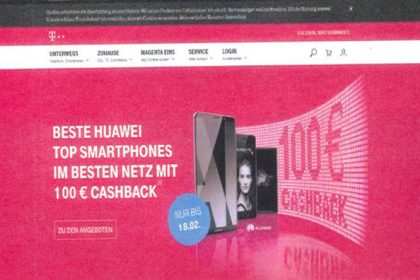Was the advertising statement ‘Top smartphones in the best network’ by Deutsche Telekom a unique selling proposition or an advertisement with a test result? The Higher Regional Court of Hamburg ruled that the reference to a test seal must already be visible on the first accessible website.

The Higher Regional Court of Hamburg (OLG Hamburg) ruled on an advertisement of Deutsche Telekom (17.12.2020, 15 U 129/19), which was placed in Germany shortly before Christmas 2020. Products and services were advertised with the statement “Best Huawei top smartphones in the best network with €100 cashback”.
A cease-and-desist letter was filed against this advertisement, but Telekom refused to issue the requested cease-and-desist declaration. Subsequently, this case was heard by the Hamburg Higher Regional Court. According to § 8 (1) UWG, anyone who carries out a commercial act that is illegal according to § 3 UWG can be sued for injunctive relief if there is a risk of repetition. Pursuant to § 8 (3 no. 1) UWG, every competitor is entitled to such a claim.
The OLG also commented in principle on the relevance of the question whether an advertising statement such as the one at issue, like ‘ Top Smartphones in the best network ‘, is to be regarded as a unique selling proposition or as a test reference advertisement. In contrast to a test reference advertisement, in which a quality claim is made but which cannot be proven by the advertiser himself, special requirements are placed on a unique position claim in an advertising statement.
Unique position claim must really be true
The case law of the German Federal Court of Justice (BGH) states that a unique position claim is only permissible if the advertising claim is true – and if the advertiser has a clear advantage over its competitors and the advantage offers the prospect of a certain consistency (BGH, GRUR 2003, 800, 803 – Schachcomputerkatalog; BGH, GRUR 2002, 182, 184 – Das Beste jeden Morgen). Otherwise, there was a risk of misleading.
Incidentally, a claim of a unique position is not only made if the advertiser claims to have no competitor at all, i.e. to “stand alone” in the literal sense of the word, but also if he expresses that he outperforms his competitors.
An “objective connection” within the meaning of § 2 (1) UWG also exists in the case of pure attention-grabbing advertising (image advertising), which does not even have to address the specific range of goods and services, but rather serves to make the name of the advertising company known to the public or to increase its public awareness and thus indirectly to promote its sales.
Pursuant to § 5 (1(2)) UWG, a commercial act is also misleading if it contains information about essential characteristics of the goods that is suitable for deception. This also includes the results of tests of goods and services.
But was this the case with Telekom’s advertisement with the slogan ‘ Top Smartphones in the best network ‘ – or did the statement “in the best network” refer to test results of the magazines “CHIP” and “connect”, as Telekom claimed?
A must: reference to the test seal on the first retrievable internet page
The OLG Hamburg denied this. The challenged advertisement of Telekom was a unique selling proposition, the court ruled. The wording of the statement “in the best network” leaves it open whether this is a test result or the defendant’s own assessment, the court explained. Unlike an advertisement with the express designation “test winner”, the statement “in the best network” only establishes a reference to a test result by displaying a test seal. However, there was no such seal on the first website accessible to the consumer.
In order to get to the corresponding test seal, the consumer in the case of the Telekom advertisement first had to click on the button “To the offers”, thus opening a new page and scrolling down slightly. This link was not sufficient to assume that the consumer perceived the advertising statement “in the best network” on the first internet page as advertising with a test result, the OLG Hamburg ruled.
Explanation of the advertising statement in the clickable asterisk
Telekom argued in vain that the advertising statement in dispute had been published in the advertisement “Best Huawei Top Smartphones in the best network with € 100 cashback” and that a clickable asterisk had been placed at the end of the word cashback. The targeted public expected to receive more detailed information on the following three topics when clicking on the asterisk: 1. “the Huawei top smartphones mentioned”, 2. “the best network” and 3. “100 € cashback”. This was indeed the case, because all this information was “provided on the downstream page”, Telekom argued.
However, the Hamburg Higher Regional Court rejected this objection. It was thus proven once again that it was only on the downstream page that the aforementioned information was contained. And the two test seals relevant in relation to “in the best network” were probably accessible anyway via the button “To the offers”, but not via the asterisk reference.
Risk of repetition
The Higher Regional Court of Hamburg therefore ruled that the Telekom advertisement ‘ Top Smartphones in the best network ‘ was a unique selling proposition that was inadmissible. Even more, the OLG Hamburg also ruled that there was a risk of repetition.
According to BGH case law, the mere cessation of advertising is not sufficient if the advertising can be resumed at any time without major effort. Even the cessation of the production of the product that was unfairly advertised and even the cessation of business of the debtor acting in an anti-competitive manner are not sufficient without further ado for the lapse of the risk of repetition (see BGH, GRUR 1998, 1045, 1046 – Brennwertkessel; BGH, GRUR 2001, 453, 455 – TCM-Zentrum; BGH, GRUR 2016, 88 marginal no. 51 – Deltamethrin). Similarly, a risk of repetition is not eliminated if there are purely factual changes. In the absence of a cease-and-desist declaration with a penalty clause, a risk of repetition was to be assumed as long as all likelihood of a resumption of the unlawful conduct by the infringer had not been eliminated (BGH, GRUR 1988, 38, 39 – Leichenaufbewahrung).
Are you also looking for protection for your product?
Our lawyers have many years of expertise in the entire field of intellectual property – trade marks, designs and patents – as well as in competition law and are entitled to represent you before any court – in Germany and internationally.
Please do not hesitate to contact us if you are interested.
Source for text and image:








Leave a Reply